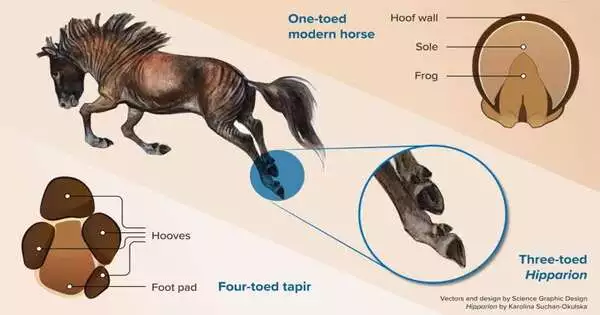Researchers say that horses’ distant ancestors had hooved toes instead of a single hoof, which disappeared over time.
The animals, like the Eocene Hyracotherium, had modern-day tapir-like feet: four toes in front and three behind, each exclusively hooved with a basic foot cushion.
Modern equids, on the other hand, like horses, asses, and zebras, only have one toe—the left-over third toe on each foot—encased in a thick-walled keratinous hoof with a triangular frog underneath that absorbs shock.
To determine what happened to the missing digits, a global team of scientists from the UK, the US, and the Netherlands examined fossil hoof prints, foot bones, and hoof prints from modern horses.
“While the idea that modern horses have kept all of their original toes as within-hoof remnants is novel and appealing, it can be demonstrated to be false.”
Author Professor Christine Janis from the University of Bristol’s School of Earth Sciences.
“The upper portions—the remains of the additional hand and foot bones—remain as splint bones’ fused with the remaining central one, but where are the fingers and toes?” was the author’s explanation, provided by Professor Christine Janis of the School of Earth Sciences at the University of Bristol.
“Only three toes existed on the front and back of later fossil horses. These horses’ additional toes, also known as side toes, were shorter and smaller than those of a tapir. In normal circumstances, they probably did not touch the ground, but in exceptional circumstances like sliding or a strong impact, they may have provided support.”
The findings, which were published today in Royal Society Open Science, back up the old idea that these toes were completely lost to evolution and not somehow kept in the hoof, as proposed in a 2018 paper in the same journal.
“Although it does seem that remainders of the proximal (upper portions) of the side digits have been retained in modern horses, as the earlier 2018 paper claimed, the distal (lower portions, or toes) have simply been lost,” said lead author Professor Alan Vincelette of St. John’s Seminary in Camarillo, California.
Although there are no actual bones in the frog, the 2018 study suggested that modern horses retain these side toes within the central toe’s hoof, contributing to the frog.
This was partially based on how the hoof prints of an extinct three-toed horse, Hipparion, from Laetoli, Tanzania, 3.7 million years ago were interpreted. This was the same location where the famous foot prints of the hominid Australopithecus were found. Hipparion was not directly related to modern horses. The fact that these hoof prints did not appear to have a frog lends credence to the idea that modern horses’ frogs are formed by the side toes of horses like Hipparion.
Although the presence of frogs in the hoof prints of modern horses with frogs is not always recorded, many hoof prints that are known to have been made by three-toed horses clearly indicate the presence of frogs. These observations cast doubt on the hypothesis that the side toes of tridactyl equids formed the frog of modern horse hooves.
“While the notion that modern horses have retained all of their original toes as within-hoof remnants is a novel one and so rather appealing, it can be shown to be incorrect,” said author Professor Christine Janis from the School of Earth Sciences at the University of Bristol.
“The frog of the horse’s hoof evolved independently of the side toes as a unique structure providing shock absorption and traction during locomotion,” Alan Vincelette added.
The team also demonstrates that the main toe of the feet of horses with one toe is round rather than oval, which differs from the shape of the feet of horses with three toes. This difference could be due to differences in weight distribution or ecological habitat.
More information: Alan Vincelette et al, ‘Hipparion tracks and horses’ toes: the evolution of the equid single hoof’, Royal Society Open Science (2023). DOI: 10.1098/rsos.230358





